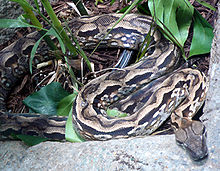- Boa madagascariensis
-
Boa madagascariensis 
Conservation status Scientific classification Kingdom: Animalia Phylum: Chordata Subphylum: Vertebrata Class: Reptilia Order: Squamata Suborder: Serpentes Family: Boidae Subfamily: Boinae Genus: Boa Species: B. madagascariensis Binomial name Boa madagascariensis
(Duméril & Bibron, 1844)Synonyms Boa madagascariensis is a species of the Boidae (boa) family that is endemic to the island of Madagascar. A common name is Madagascar (or Malagasy[2]) ground boa.
Contents
Description
The species is included in the Boidae family of snakes, subfamily Boinae, no subspecies are currently recognized by ITIS.[3] It is also described as a species in the genus Acrantophis.[4][5]
Adult females can be up to 10 feet (3.05 metres), males are typically smaller, the average size of the population is 8 feet (2.44 m) in length.[2] This is the largest snake species found on the island of Madagascar. Boa madagascariensis, like others in the family, dispatch their prey by constriction.
The color pattern consists of a pale reddish-brown ground color mixed with gray, overlaid with a pattern dorsal rhombs outlined with black or brown. Sometimes this creates a vague zigzag impression. The sides are patterned a series of black ovoid markings with reddish blotches, often bordered or centered with white.[2]
Geographic range
Endemic to Madagascar.[1] Occurs in the central and northern parts of the island.[2] The type locality given is "Madagascar."[1]
Habitat
The species usually occurs in sparse, open woodland[2] such as the Madagascar dry deciduous forests).
Conservation status
Boa madagascariensis is classified as Vulnerable (VU) on the IUCN Red List of Threatened Species with the following criteria: A1cd (v2.3, 1994).[6] This means that a population reduction of at least 20% has been observed, estimated, inferred or suspected over the last 10 years or three generations, whichever is the longer, based on a decline in area of occupancy, extent of occurrence and/or quality of habitat, and based on actual or potential levels of exploitation. Year assessed: 2006.[7] It is also listed as CITES Appendix I, which identifies it as threatened with extinction and recommends a prohibition in international trade except for scientific research.[8]
Threatened by deforestation, human population growth, and agricultural and industrial development, it has been considered endangered since 1977.[2]
Behavior
Shelters in mammal burrows, fallen trees, debris piles and similar sites that offer some protection. Hibernation takes place during the cool and dry winter months, usually May though July.[2]
Feeding
The diet consists of small mammals and birds.
Reproduction
Mating takes place after emerging from hibernation. Females may be courted by and copulate with more than one male. Ovoviviparous, females give birth to 4-6 large young after a long gestation period of 4-6 months. Neonates are 19-24 inches (48-61 cm) in length and are already capable of feeding on small rodents and birds.[2]
See also
- List of boine species and subspecies
- Boinae by common name
- Boinae by taxonomic synonyms
References
- ^ a b c McDiarmid RW, Campbell JA, Touré T. 1999. Snake Species of the World: A Taxonomic and Geographic Reference, vol. 1. Herpetologists' League. 511 pp. ISBN 1-893777-00-6 (series). ISBN 1-893777-01-4 (volume).
- ^ a b c d e f g h Mehrtens JM. 1987. Living Snakes of the World in Color. New York: Sterling Publishers. 480 pp. ISBN 0-8069-6460-X.
- ^ "Boa madagascariensis". Integrated Taxonomic Information System. http://www.itis.gov/servlet/SingleRpt/SingleRpt?search_topic=TSN&search_value=634788. Retrieved 10 July 2008.
- ^ Acrantophis madagascariensis at the Reptarium.cz Reptile Database. Accessed 10 July 2008.
- ^ Vences M, Glaw F, Kosuch J, Böhme W, Veith M. 2001. Phylogeny of South American and Malagasy Boine Snakes: Molecular Evidence for the Validity of Sanzinia and Acrantophis and Biogeographic Implications. Copeia No 4. p. 1151-1154. PDF at Miguel Vences. Accessed 29 August 2008.
- ^ Acrantophis madagascariensis at the IUCN Red List. Accessed 10 July 2008.
- ^ 1994 Categories & Criteria (version 2.3) at the IUCN Red List. Accessed 10 July 2008.
- ^ Acrantophis madagascariensis at CITES and United Nations Environment Programme / World Conservation Monitoring Centre. Accessed 10 July 2008.
Further reading
- Kluge AG. 1991. Boine Snake Phylogeny and Research Cycles. Misc. Pub. Museum of Zoology, Univ. of Michigan No. 178. 58 pp. PDF at University of Michigan Library. Accessed 11 July 2008.
- Vences M, Glaw F. 2003. Phylogeography, systematics and conservation status of boid snakes from Madagascar (Sanzinia and Acrantophis). Salamandra, Reinbach, 39(3/4): p. 181-206. PDF at Miguel Vences. Accessed 29 August 2008.
External links
 Media related to Boa madagascariensis at Wikimedia Commons
Media related to Boa madagascariensis at Wikimedia Commons  Data related to Boa madagascariensis at WikispeciesCategories:
Data related to Boa madagascariensis at WikispeciesCategories:- IUCN Red List vulnerable species
- Boinae
Wikimedia Foundation. 2010.


